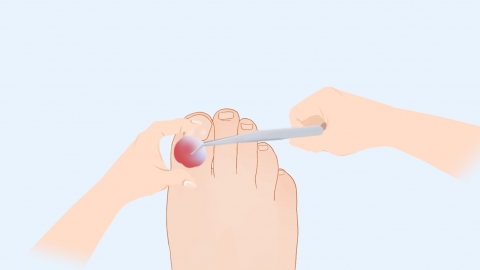What causes pain on the right side of the left heel?
Generally, the main causes of right-side pain in the left heel include overuse injury, Achilles tendinitis, plantar fasciitis, heel spurs, and gouty arthritis. If discomfort occurs, it is recommended to seek timely medical evaluation and treatment at a正规 hospital. Specific analyses are as follows:

1. Overuse Injury
Prolonged standing, walking, or engaging in activities such as running and jumping can place continuous stress on the muscles and ligaments on the right side of the left heel, leading to localized aseptic inflammation and pain. Daily management includes reducing weight-bearing time on the foot, avoiding strenuous exercise, soaking feet in warm water after physical activity to promote local blood circulation, and gently massaging the muscles around the heel to relieve fatigue.
2. Achilles Tendinitis
Repeated strain on the Achilles tendon—such as frequent toe-raising or inadequate warm-up before exercise—can cause inflammation at the tendon's attachment point on the right side of the left heel, resulting in pain and swelling. During the acute phase, rest and immobilization are necessary. Under medical guidance, medications such as ibuprofen sustained-release capsules, diclofenac sodium sustained-release tablets, or naproxen sodium tablets may be used to reduce inflammatory pain. After symptoms improve, Achilles tendon stretching exercises can help enhance tendon flexibility and resilience.
3. Plantar Fasciitis
When the plantar fascia remains under chronic tension—due to ill-fitting footwear or conditions like flat feet—it can become strained and inflamed at its origin on the right side of the left heel, causing pain. Under medical supervision, drugs such as celecoxib capsules, etoricoxib tablets, or loxoprofen sodium tablets may help alleviate symptoms. Additionally, wearing shoes with proper arch support and performing plantar fascia massage before bedtime can aid in relaxation.
4. Heel Spur (Calcaneal Spur)
Long-term pressure on the heel bone can lead to subperiosteal bone proliferation, forming a bony spur. This spur may irritate surrounding tissues on the right side of the left heel, causing pain. For mild cases, heat therapy or ultrasound physiotherapy may help relieve discomfort. Medications such as indomethacin enteric-coated tablets, meloxicam tablets, or lornoxicam tablets may be used under medical advice to reduce inflammation. In severe cases where the spur causes significant compression, surgical removal of the heel spur (excision of the osteophyte) may be required.
5. Gouty Arthritis
Abnormal uric acid metabolism leads to deposition of uric acid crystals in the joint on the right side of the left heel, triggering inflammation that manifests as severe pain, redness, and swelling. During acute attacks, medications such as colchicine tablets, allopurinol tablets, or febuxostat tablets may be prescribed to lower uric acid levels and reduce inflammation. Daily management should include limiting intake of high-purine foods—such as organ meats and seafood—and increasing water consumption to promote uric acid excretion.
In daily life, it is important to wear comfortable, well-fitting shoes and avoid those that are too stiff or tight. Exercise intensity and duration should be controlled to prevent overuse. Maintaining a healthy body weight helps reduce stress on the heels. Regular attention to foot health is essential; if heel pain persists or worsens, prompt medical evaluation is advised.




